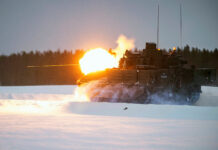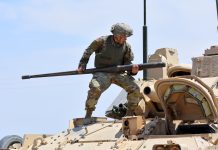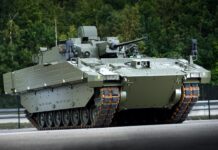In August 2023, ESD interviewed the Honourable James Cartlidge MP, Minister for Defence Procurement (MinDP) at the UK’s Ministry of Defence (MoD). The interview was conducted by Mark Cazalet and Stephen Barnard.

Credit: UK MoD
At the June House of Commons Defence Committee (HCDC) hearing, MinDP said there are “positive changes happening” regarding defence procurement. What are these changes at a granular, technical level? Do these “positive changes” factor in any of the lessons learned from HCDC’s recent report?
We are delivering practical change and improvement across our acquisition system. That progress is demonstrated by us already seeing a one-year reduction in the average time it takes to deliver a capability to our forces – the kind of positive progress we must capitalise on and continue to drive forward. As acknowledged by the HCDC, we have also seen positive changes at DE&S – not least the very effective effort undertaken to procure for Ukraine, often at great speed.
Work is ongoing to learn the lessons from Ukraine but also the HCDC report, and in particular, the Sheldon Report into Ajax – but should lead to a recognisably improved procurement system in the future, as we start to implement those lessons. This will in particular include ensuring we have the right people in place, to build a cadre of qualified programme leaders. We are ensuring our procurement processes are proportionate to each programme. And we are engaging the right experts, and industry, earlier in the process so that we set programmes up for success from the outset.
With the next general election just over a year away, and current polling not favouring the Conservative party, is meaningful reform of UK Defence procurement a high priority for the current government? If so, which resources are being committed, or major structural changes being implemented to help bring this about?
Reform of defence procurement is absolutely a priority for this government and we’re leading the most robust review of the end-to-end acquisition system for a decade. We need to drive greater pace and agility into how we acquire military capabilities for the front line, ensuring we can outmatch the threats we face both now and emerging threats we’ll face in the future.
This could well see us breaking from past practice and accepting capabilities that are 80% developed to ensure we’re not losing the strategic advantage. The priority will be delivery rather than perfection – a key lesson we’ve learned from Ukraine, with the emphasis on spiral development ‘once in service’ rather than overly lengthy procurement up to that point.
Ultimately, what matters here is the national interest. We have played a huge role in supporting Ukraine, and procurement has been a big part of that – not just in terms of direct support, but in ensuring that the 20,000 Ukrainians trained in the UK have adequate kit, where it is our responsibility to provide it. Whatever the political calendar, the overriding strategic imperative is to keep maximising our support for Ukraine, whilst reforming procurement processes to ensure our armed forces have the best possible equipment.
New IOC dates for Ajax have been announced. What has changed to make this date a realistic target?
Careful, detailed measurements and analysis of the noise and vibration characteristics on the vehicles was completed to allow the correct design changes to the seating. To ensure these are the correct solutions has required extensive and complex analysis and testing of the platform. A range of modifications beyond revised seating have also been integrated onto the vehicle and its electronic architecture.
With a delivery schedule completely rebuilt, in recognition of the mistakes of the past and the optimism bias that existed in the previous schedule, we’re clear that Ajax remains at the heart of the Army’s modernisation programme. When I was recently given a test drive of the Ajax platform, the soldiers I was sitting alongside were incredibly positive – describing a real step change in capability, including greater lethality but also manoeuvrability, and absolutely cutting-edge sensors and comms. The Army recommenced regular field training on Ajax in June and Reliability Growth Trials continue to progress well, with well over 10,000 km driven since January, testing the durability of the platform and components through a series of battlefield missions.
Under the Defence Command Paper 2021 (DCP21), the UK’s Warrior IFV is slated for retirement from 2025. What is the MOD’s plan to fill the IFV capability gap – bearing in mind that none of the Boxer variants currently on order have the right weaponry mix to fill the IFV role? Is the MoD considering pushing back Warrior’s retirement date, or re-roling Ajax to become Warrior’s de facto replacement?
There’s been no change in plan from our 2021 Defence Command paper, which made clear Warrior will remain in service until the introduction of new capabilities, including Boxer, which we anticipate will happen from the middle of this decade – Boxer is still expected to enter service from 2025 and we have no plans to extend Warrior to 2030.
Although Boxer is not directly replacing Warrior, this approach will ensure that, alongside capabilities including Apache AH-64E, Challenger 2 tanks and Ajax, the Army can continue to meet its operational commitments.

Credit: UK MoD
The Defence Command Paper 2023 (DCP23) provided little new money for procurement programmes and stated: “there are deliberately no new commitments on platforms at all – because on that we stand by what we published in 2021.” Yet this claim rings somewhat hollow considering the War in Ukraine started since DCP 2021 was published, and stands in stark contrast to what many UK allies have done over the same time period. How does the MOD plan to meaningfully modernise the Armed Forces without committing to new platforms?
The Defence Command Paper 2023 was developed in lock-step with the lessons we’re learnt – and continue to learn – from Russia’s illegal invasion of Ukraine. The publication followed an uplift of GBP 5 Bn over the next two years to improve the readiness and resilience of our Armed Forces. The document was also underpinned by an additional GBP 2.5 Bn being prioritised on bolstering munitions and stockpiles over the coming years – new investment that is very specifically the result of the war in Ukraine, and our need to replenish following the extraordinary support we have provided to the Ukrainian armed forces.
We already have a GBP 242 Bn Equipment Plan to cover procurement programmes for the next decade and we are focusing on how to drive the lessons of Ukraine into our core business and to recover the warfighting resilience needed to generate credible conventional deterrence.
DCP23 demonstrated how we will modernise and adapt to the changing global picture and, in particular, how we will prioritise investment in science and technology to ensure we have a force greater than the sum of our parts.
In this more volatile, complex and ambiguous security environment, we must embody a fully integrated approach to deterrence and defence – including across domains, across the spectrum of competition, across government, and with our allies and partners.
Recently, we have seen that the Urgent Capability Requirement (UCR) system works well in terms of delivering necessary capabilities in-theatre. Why not adopt that system for broader acquisitions?
When time is of the essence, we have shown that we can prioritise early delivery of capability. But by definition, every acquisition programme cannot be a priority. With UCRs, the time imperative means we take greater risk, balancing this against the need to deliver equipment into the hands of our personnel quickly. We need to consider where we could take more risk in order to drive pace. We are placing increased emphasis on timely delivery across the board, including through iterative or ‘spiral’ development where, for example, we might accept an initial solution that does not fully meet our requirements if we can get it more quickly. We can then build on this, improving the capability over time.
The message has also been reinforced in recent months and years that rebuilding sovereign manufacturing capabilities, and the supply chains to support them, is fundamental to national security. What steps have been taken to address the UK’s apparent shortcomings in these areas?
To an extent, Defence has always recognised the importance of having onshore industrial capability – warships and submarines being obvious examples.
The Defence and Security Industrial Strategy took that a step further and set out a more systematic approach for looking at the national security and operational needs for an onshore industrial capability, including those where there is a strategic imperative for the majority of the industrial capability to be onshore. It doesn’t mean we should try to do everything onshore – that’s not affordable, practicable, or even necessarily desirable – but it does mean we shouldn’t revert to international competition by default in our commercial strategies. We need to be smarter, look at the military and operational requirements for an onshore industrial capability, and shape our approach to the market accordingly.
The Defence Command Paper 2023 also recognises this, making the point that we needed to go further in looking at our supply chains so they are resilient to disruption and can ensure we have access to key materials, components, and critical technology. We will be enhancing our national resilience through a combination of shaping MOD orders, exports, and civil demand. But it also means working with our international partners to improve our supply chains’ collective resilience including through friend shoring, particularly where our supply chains are global in nature.











